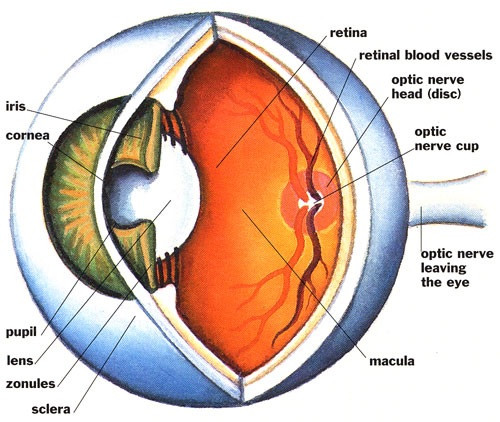How does the eye work?
Eyes are small but extremely important organs in human life. The eye is the visual organ that performs the function of looking, observing, and retrieving images of things and colors to transfer into the brain for processing and storage.
The ability of the human eye to create images is a series of surprisingly complex events, demonstrating the need to take good care of eye health. It starts when the outer light rays focus on the image processing area of the eye, called the retina . This process depends on the different anatomical structures of the eye, working together to accurately grasp the complex images of the world.

Structure of the eye.
First, light passes through the cornea often transparent. Then, the two muscles control the iris, making the pupil smaller or larger, allowing light to enter the eye. The body is the muscle that controls the shape of the lens to focus light rays into the retina, where the brain then begins processing information. The retina consists of rod-shaped and cone-stimulating light cells, which hold the energy of light rays and transmit electrical signals to the brain.
Rhodopsin is a chemical in the light-stimulating cells of the retina that holds the light back for processing. Unfortunately, Rhodopsin is quite sensitive and lost after continuous exposure to light. Therefore they must be added. Vitamin A is essential for the production of retinal, which is part of the rhodopsin molecule.
The critical area for capturing and processing light wavelengths to give sharp images is the golden point area, the central part of the retina. The health of the yellow spot, which contains a large number of light-stimulating cells, is important in securing the essential part of the market. If the area is damaged or damaged, a large portion of the market will be lost in the central part represented by a large black spot.
Many lifestyle conditions can affect the health and integrity of the macula, so harm reduction and / or eye health should be reduced. If all of these structures are active in good health, the images transmitted to the brain through the optic nerve are better received and interpreted.
- 6 ways of 'brain scams' make people work harder
- Early work is not conducive to health
- Identify deceitful people at work
- Bring your dog to work to reduce stress
- Research science: People who tend to be late often live longer and smarter
- Science proves that we should only work 4 days a week
- Gen D2 decided on the effectiveness of the work
- Sadness is also good for work
- Work related reasons make you die early
- The reason many people cannot concentrate on work
- Sorrow can help you work more effectively
- Female network administrators are often cherished by colleagues
 'Fine laughs' - Scary and painful torture in ancient times
'Fine laughs' - Scary and painful torture in ancient times The sequence of numbers 142857 of the Egyptian pyramids is known as the strangest number in the world - Why?
The sequence of numbers 142857 of the Egyptian pyramids is known as the strangest number in the world - Why? History of the iron
History of the iron What is alum?
What is alum?